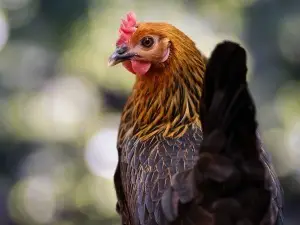
Chickens usually get around just fine, these animals will use their legs to walk, run and jump around. A crippled chicken will have a lower quality of life but it can still live well enough with your support.
This article looks at raising a crippled chicken
Crippled chicken, Steps On Taking Care Of Your Bird:
A crippled chicken is more vulnerable than an able-bodied chicken, but this does not mean that it can’t live a full and enjoyable life.
You can give this bird a chance at life by offering the bird a comfortable place to live, support if needed, and the correct nutrients. This is how to take care of a crippled chicken:
Assess your bird:
If you’ve just received or adopted your bird, start off by assessing how much movement the bird still has.
Her level of mobility can be assessed by leaving some delicious food, like watermelon, a distance away from her and seeing if she will try to rush over to the watermelon, freeze up, hide her head, or sit motionlessly.
Make adjustments for her:
If your chicken is crippled you’d need to spend more money on not only her vet visits, but on her accessories and on her coop as well.
A crippled chicken needs her own feeder, her own waterer, extra bedding, extra coop space, and a roost that is easily accessible to her.
All this is necessary because these birds will quickly get picked on and bullied away from communal feeders and waterers. Thus they need more space and their own feeders and waterers.
Give her access to a number of places, which are accessible to her, where she can move around freely. This will keep her body and her mind stimulated.
If you can, give her both indoor and outdoor spaces to move around in, also, give her access to different surfaces to keep her stimulated.
Give her access to pillows, cushions, good bedding, and baskets that are thick, soft but firm, and make sure they are large enough to accommodate her.
Adding polyester/plush blankets to the cushions will make it easy for you to remove them and regularly clean them.
Give her exercise time:
Crippled birds have reduced mobility, a lack of movement is bad for birds so giving them the opportunity to exercise will keep them from becoming sick too early.
Exercise for crippled birds will look like the bird moving around, flopping, wriggling, and mild panting.
You’d need to keep an eye on the bird during this time, too vigorous exercise, like the bird panting heavily or violently thrashing around, can cause the bird to become injured, dislocate something, or suffer from a panic attack.
Allow the bird to exercise on flat nonslip surfaces that are clean, stable, and non-abrasive. Putting the bird in a sling or in a therapy chair will help it stand for some periods of time which will be helpful.
Give her access to dust baths:
A chicken is still a chicken and will benefit from a dust bath regardless of whether it is crippled or not.
Just like any dust bath, make sure that the sand is at least 2 inches deep and that the sand has no herbicides, pesticides, or fertilizers in it. Also, make sure that the sand is not too hard-packed or abrasive for your crippled bird
Keep an eye on your bird:
A crippled bird may have some success in moving, but there are still cases where the bird will not know what to do or how to act because its movement is limited.
Keeping an eye on her will ensure that you’ll always be there if she needs help or if she is in a dangerous situation that she can’t seem to get out of.
Avoid diapers:
Diapers may be convenient for you, but they aren’t the best for chickens, diapers are not comfortable for birds, in addition, they keep the bird’s feces close to the bird’s skin for extended periods of time. This is not good for the bird’s skin.
It would be better to let the bird poop freely, scoop the poop up and clean the surface that it pooped on if needed.
You can alternatively use an ace bandage to fit an adult diaper on the bird. These draw moisture away from the bird’s skin and aren’t irritating
If you enjoyed this article then you may also be interested in other chicken related articles. Here are some articles that you may be interested in: Chick Leg Problems, Chicken Sprained Leg, Chicken Falling Over To One Side, Paralysis In Chickens Caused By Argas

